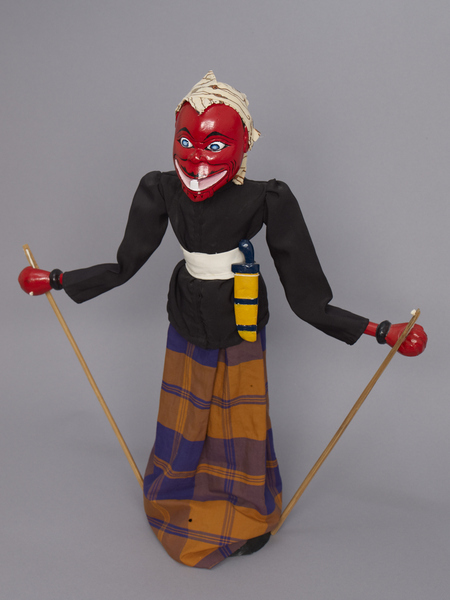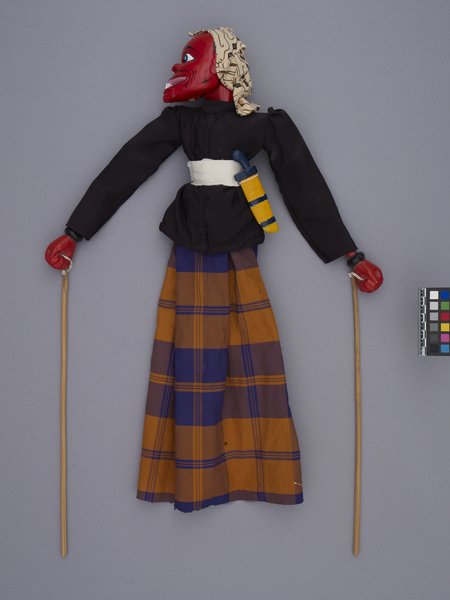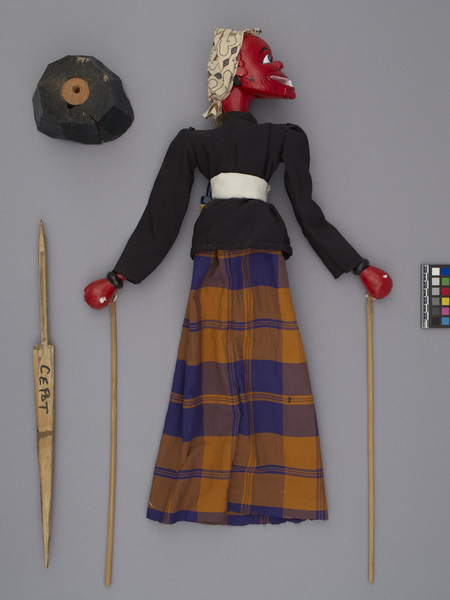Rod Puppet Item Number: 2872/33 a-c from the MOA: University of British Columbia



Description
Panakawan (clown) puppet named Cepot. A piece of fishing line holds the head to the body (part a) and due to a metal piece in the interior, the head is able to nod. The face is red, with blue eyes, a small nose, and an open mouth that displays one white tooth. The lower lip protrudes out past the upper, which is lined with a small black moustache. The clothing is village style, with a scarf covering the scalp, a long sleeved black jacket with a white sash, and a long checked sarong. A white string around the waist holds a sheathed dagger. The sarong hides a removable wooden stick (part b) that extends through the torso to control the movement of the head and connects the figure to its blue wooden base (part c). The arms are moveable at shoulder and elbow by wooden sticks attached to each hand.
History Of Use
Javanese puppetry as an art form probably developed by the 11th century. The three-dimensional wooden wayang golek puppets of western Java, which are to be distinguished from the earlier and more sacred wayang kulit shadow plays puppets or other forms, appeared during the 16th century. Originally the plays depicted Javanese mythology, but after the Indian conquest of Java the Hindu epics, Ramayana and Mahabharata, were incorporated into the cycles, which comprise about 200 plays. An individual or group hires a dalang (puppet-master) to celebrate important occasions. The performances often last all night and are generally presented in three acts, with vocal and instrumental accompaniment. The individual plays vary widely in detail but usually involve conflict between good and evil. They serve a moral and religious purpose, and more recently, one of political commentary. Each puppet's character is represented by its appearance and placement on stage; protagonists with strong elements of good are placed to the right, antagonists of violent or evil nature to the left. The Panakawan puppets are “clown-servants”, providing comic relief and commentary and acting as aids and advisors to the hero of the play. They represent common villagers. Role is commonly trivial buffoonery, they present a contrast to their refined lords, who they often parody along with their high ideals and interplay with the gods. The Panakawan serve to cast the Hindu tradition in a more acceptable, human light. They are an intermediary between the gods and the nobles who they serve, and the more common audience, who themselves display characteristics of both good and evil. The Panakawan provide levity to the plays and also to the more serious spiritual concerns, which demonstrates the flexibility and perhaps accounts for the continuing popularity of the rich and sophisticated tradition of Indonesian puppetry.
Iconographic Meaning
Cepot, or Astrajingga, a punakawan (clown-servant) character.
Item History
- Made in West Java, Indonesia
- Collected between 1990 and 1999
- Owned by Betty Cairney
- Owned by Jack Cairney before March 15, 2011
- Received from Jack Cairney (Donor) on March 15, 2011
What
- Name
- Rod Puppet
- Identification Number
- 2872/33 a-c
- Type of Item
- puppet
- Material
- wood, cotton fibre, paint and metal
- Overall
- height 55.0 cm, width 17.0 cm, depth 37.0 cm
- Puppet
- height 77.0 cm, width 17.0 cm, depth 9.5 cm
Who
- Culture
- Sundanese
- Previous Owner
- Betty Cairney and Jack Cairney
- Received from
- Jack Cairney (Donor)
Where
- Holding Institution
- MOA: University of British Columbia
- Made in
- West Java, Indonesia
When
- Collection Date
- between 1990 and 1999
- Ownership Date
- before March 15, 2011
- Acquisition Date
- on March 15, 2011
Other
- Condition
- good
- Accession Number
- 2872/0033 a-c